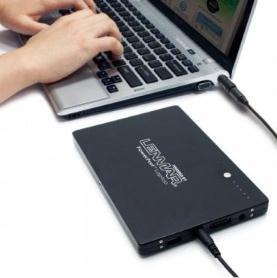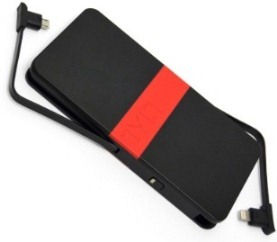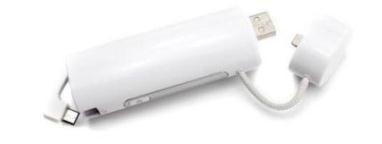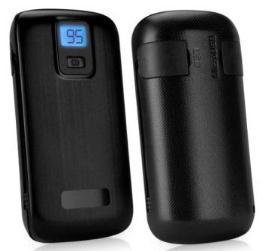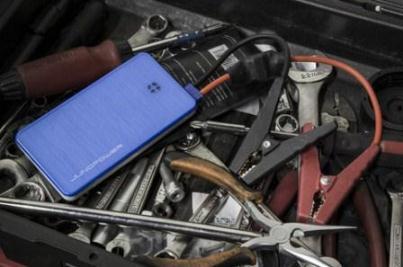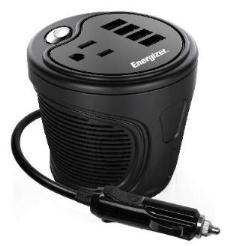For reasons I can't quite explain, I love portable chargers. Much of that has to do with how elegantly they're designed. There's a class of products that pull at my heartstrings - camping gear is high on that list - that have to be designed with great efficiency, and portable chargers fall into that, particularly with the grown of portable devices. Far more than just a battery pack, the best of them need to be small and light, yet powerful, and with external accesories built in to increase their functionality - some today even allow for solar charging. (More on that in a later column.) This month, we look at an assortment of portable chargers that cover a range of needs. One even lets you charge appliances that you'd normally plug into the wall of your home. So, power on...
- Lenmar Portable Power Pack for Laptops
- TYLT Energi 5K+
- Xtorm Power Bank 2600
- Rejuva Power Pack Pro
- Juno Power JUMPR
- Energizer 180 Watt Cup Inverter
For all my love of portable chargers, one of the more difficult to find are those for laptops. The issue tends to be the size and voltage. The only one I'd found up to now that I thought was respectable came from a Dutch company, Xtorm, sold only in Europe or online. The upside is that it also can be solar-charged and it was reasonably portable. The downside is that it's still a bit heavy-ish for happy portability.
So, it was a pleasure to find another entry in the field from Lenmar, which makes a large line of chargers. The laptop model is very thin, making it easy to slide into a briefcase or your laptop case, and acceptably light at just over one pound. To be clear, it's not "light" per se, but enough so when traveling to make it very convenient, particularly on long distance flights. It measures 7"x5" by .5".
The capacity is a solid 16,500 mAh (milliamp). This won't fully charge your laptop, but will still give you several hours extra, which should be plenty for most circumstances, not leaving you stranded in mid-flight, say.
Unlike tablets and mobile phones that tend to have standard ports, most laptop manufacturers have proprietary plugs. As a result, you can't just snap this charger in, but need adapter plugs, which the Lenmar comes with. Find the right one for your laptop and attach it to the charger's cord. (The manual had a listing of all computer models and the appropriate plug. I found it easier just using trial-and-error to see which fit.) Also, you have to set the charger for the correct voltage - 16 or 19 V - but that's easy to determine since most laptops should list their voltage on the bottom. The included tips should work for most laptops on the market, but know that there could be some that aren't covered. This is common will all such products that require adapter plugs, occasionally because laptop company change their proprietary connectors.
Charging the Lenmar isn't as easy as just plugging it into the well, though it's hardly a challenge. It has to be plugged into your laptop's charger (attaching it with another, included plug) and then that is what you plug into the wall. Like many chargers, it charged quickly for the first 90%, a couple of hours or so, but the last 10% trickle-charge took a long while, an additional 1-1/2 hours. Of course, if you don't mind doing without that last 10% capacity, you can always stop before it's fully charged.
The device will also charge Smartphones, though oddly cannot charge tablets which require a 2.1 amp input port.
The Lenmar Portable Pack for Laptops was a pleasure to come across - it not only helps fill a great need, but does so quite well and conveniently. It would be nice if it could also charge tablets, but that's not an issue. It does what it's meant for and does it well. My only quibble was deeply minor - it had one of the worst, most convoluted manuals I've come across that was actually confusing. Happily, the company has informed me that they've completely re-done the manual, and I was sent a PDF of an advance copy of the Quick Start - and it was drastically improved. It should be ready by the time this review appears.
At the time of writing, it retails for $100, but could be found online for $81.00.
TYLT is perhaps best known as a maker of cleverly (and elegantly)-designed cables, though the company makes products in other areas. One is portable chargers, and their Energi line fits in with the company's elegant tradition.
The power pack is only about a half-inch thick, and weighs just 3.5 ounces. (It's 5.5 inches - a bit taller than most - but under 3 inches wide.) There are even smaller models in the Energi line, but the nice thing about the 5K+ is that it has a micro-USB plug and an Apple Lightning plug both built-in. It also holds a seriously respectable 5.2 mAh which should give at least three charges of a mobile phone. There's also a USB port if you have a device that requires a different connector.
Nice, too, is that you can use all three connections to charge three devices at the same time. On the downside, the 3 amp output isn't shared - each has a separate limit of 1 amp. )That would make for less-than-ideal charging of a tablet. In fairness, most small chargers aren't made for use with tablets.) Overall, too, it's not the fastest charger on the block
One other major plus with the design. The built-in cords are long enough that when charging you can simply lay your phone flat on the power pack and hold them together in one hand, allowing you to use your phone conveniently at the same time, rather than awkwardly try and hold the two when making a call. And like much of the TYLT products, it's solidly made and of impressive quality.
Two very small quibbles. There's no built-in AC plug, like the previously-reviewed myCharge devices have - though this keeps the Energi thinner and lighter, which is a strong trade-off. And also, the power indicator is just a single light, rather than a string of lights. Not a big deal, but I prefer the latter since there's no having to remember what a specific colored lights or flashing light means.
At the moment, the Energi 5K+ retails for $90. It's pretty new, so I couldn't find a lower online price. This isn't inexpensive, though definitely in the range of similar high-quality units. As I said, though, if you want something smaller and less expensive, TYLT makes models that fit in with that. And if you don't need both built-in cords, you can save there, as well. (The Energy 3K - 3 mAh and a microUSB cord only - retails for $50.) But the double convenience and added power of such a well-designed and reasonable compact unit are well-worth considering.
Xtorm is a Dutch company I've written about in the past - and mentioned above -- perhaps best-known for its solar power devices, though it does much more. Their products aren't readily available in the United States, but they can be purchased online or in Europe.
The Power Bank 2600 is a slightly different item from the other units. It's really meant as something very small and light - about half the size of a cigar - that you can easily stick in your pocket. Yet it's still reasonably powerful, holding 2600 mAH which can almost give you two full charges of a mobile phone.
Also, though small, it's full-featured, and has a built-in plugs for both Apple Lightning and microUSB. (The official name of the product says it's "...for iPhone 5/5S. But in truth it's made for any Android or Windows Phone, as well.) There's also a standard USB plug for charging. The cap is connected to the body with a small cord, which sticks out, but ultimately having it is a Good Thing because you won't ever lose the cap.
I have mixed feelings about its use of the USB plug for charging. Most chargers have a USB port, which you connect to an outlet with a standard cord. There's no USB port here though -- the package does include a proprietary extension cord, though the last thing we need in the world is one more non-standard cord to keep track of. On the other hand, with the USB plug built-in, you can simply snap it into any USB port (like one on your computer) and charge with no cord even necessary. That's exceedingly convenient. And on balance, for something this small, it's probably the far better way to do it.
(There being no USB port is a slight downside, though not critical. But if you have a device that requires a miniUSB plug, there's no place to plug in a cord for it.)
Overall, I like the Xtorm Power Bank 2600 for those who want a very small charger for easy, very light portability. If you want something that has a USB port for expansion, this isn't for you. But for most people that's not an issue. It retails for 49 Euros, which is $68, a bit on the high side but you're getting great portability that well-designed with built-in plugs.
When reviewing another product from Boxwave, the company sent me a portable charger they sell. As long as I had it, I figured I might as well take a look. I don't get the sense that Boxwave makes the charger, but is just a third-party reseller, since its own products tend to be generally high quality. The charger had done nice features, but had too many downsides with so many others in the market to choose from.
On the positive side, it's small and light, smaller than a pack of cigarettes. There are built-in USB and microUSB plugs, which I like, though none for the new Apple Lightning plug - however there is of course a USB port to plug in a cord. It also has an attachment for the old, 30-pin Apple plug which could come in hand in case you have a legacy device, and also one for mini-USB. The capacity is 4400 mAh, good for about three charges of a Smartphone. There's also one great feature: an LED screen shows exactly what percentage of charge is left.
Built-in plugs are great, as I said, though here they're awkwardly designed. They don't just slip back into their slots but you sort of have to maneuver them back. It's easy enough, but not smooth and a bit annoying. The charger doesn't feel as well-made as many other powerbanks I've tested. It charged fine, but was problematic recharging. Two to three hours should be normal, but after six hours, it only went up 20%. I tried several times, with the same result. It's certainly likely that the device was defective, though there were enough other issues I wasn't crazy about. It retails for $70, but can be found online at the time of writing for $37.
On the surface, the JUMPR is a respectable portable power bank, about the size of a smart phone, with some downsides. It holds 6,000 mAh, enough for around four full charges of a mobile phone and is very thin with a lithium polymer battery, though unfortunately doesn't have any attached cables, so you have to carry around your own.
But the JUMPR isn't about the surface and is far from ordinary. Most notably, it can output 12 volts of power at 300 amps. So what, I hear you cry? Well, this means that the JUMPR can, in fact, charge your 4-cylinder or 6-cylinder car battery if it dies on you. Yes, you read that right. It might take a few minutes for the charge, but that beats being stranded.
It's not that the JUMPR "can" do this, it's the core feature and comes with a proprietary jumper cable. Consider that the standard portable car battery/generator that you might stick in the trunk weighs 25 pounds. The JUMP is only seven ounces, and you can store it in your glove compartment. To be clear, it can also do regular charging of portable devices, even tablets which requires a more powerful 2.1 amp output than the 1 amp which mobile phones require.
It's a very well-designed, solidly constructive device. It's a little heavier than most standard chargers, though not much, coming in around eight ounces. The automobile charger cable has a "fuse box" built in, which will protect the device from accidentally getting fried by a reverse charge. Also nice is that holding the power switch down turns the charger into a flashlight (very convenient if it's night when you're playing around under your car's hood).
The JUMPR retails at $90, though was on sale at the time of writing for $70. It works fine as standard charger, though others are much more preferable to me due to their having built-in cables. But the strength of the JUMPR - indeed, the reason to consider it - is because it can give you the peace of mind of having a backup battery for your car - which you can keep in your glove compartment or coat pocket.
This is an offbeat product that you may never use, but if you ever do have need of it - and that need is not uncommon - it's incredibly useful. Basically, what an inverter does is connect to your car battery, adapts the car's battery to AC, and let you plug an appliance into it. So, for instance, if you're having a power failure and working on a laptop and you run out of power, you're not out of luck. You can just go to your car, connect the inverter (it's brain-dead easy, using the cigarette lighter slot) and plug your device in. Any device that requires an AC plug, as long as it fits under the 180 watt ceiling.)
(You can plug in more than that. It also has slots for four USB devices, all at the same time. The 2.1 amp of the ports are shared, so if you want to charge something that requires the full 2.1A, like a tablet, you probably would have to charge alone.)
To be clear, it's only this particular device that has that 180 watt requirement. Energizer makes a line of inverters, from a low of 120 watts up to a larger, heavy duty 2,000-watt unit. But since our focus here is more the home office and items of interests, in particular, to writers, I chose to look at the lower, less-expensive and more-portable end.
The device is called a "cup inverter," because as you can see it's somewhat shaped that way and conveniently sits in your car's cup holder. You can also attach it directly to a car's battery, and the package comes with a miniature charger cable. I suppose there could be circumstance where this would be necessary, so it's good to have the cable, but plugging into a cigarette lighter socket is oh-so-much easier - and safer.
Your car doesn't even have to be on for the inverter to work. Just plug it and plug in the device to charge, and it immediately draws power from the car battery. If you do that, though, know that you start draining the car battery, so there's a limit how long you can charge. (The manual explains all this clearly.) If you start your car, though, this isn't an issue. There might be times, however, when you wouldn't want to do that - the power might be out because of a storm, so your car is in the garage, and running a car in a closed garage for a long time isn't especially wise. You may also not want to use up the gas.
Even if you aren't having a power outage, there are still uses for the cup inverter. At its most basic, the inverter gives you four USB ports to use in your car. And if you're driving on the road with some device that requires AC power, this will allow for that.
I was very impressed with the simplicity and convenience of the Cup Inverter, but mainly for the peace of mind it offers in case of a power failure. I also think the 180-watt version is preferable to the 120-watt one. Though at $55 it costs $10 more retail (not all that much for more power), at the time of writing it could be found online for merely a whopping eight cents (!) more - around $30.
*
"The Writers Workbench" appears monthly on the website for the Writers Guild of America. To see this entire column, with complete product graphics and additional "TWW Notes," please click here
To read more from Robert J. Elisberg about this or many other matters both large and tidbit small, see Elisberg Industries.

